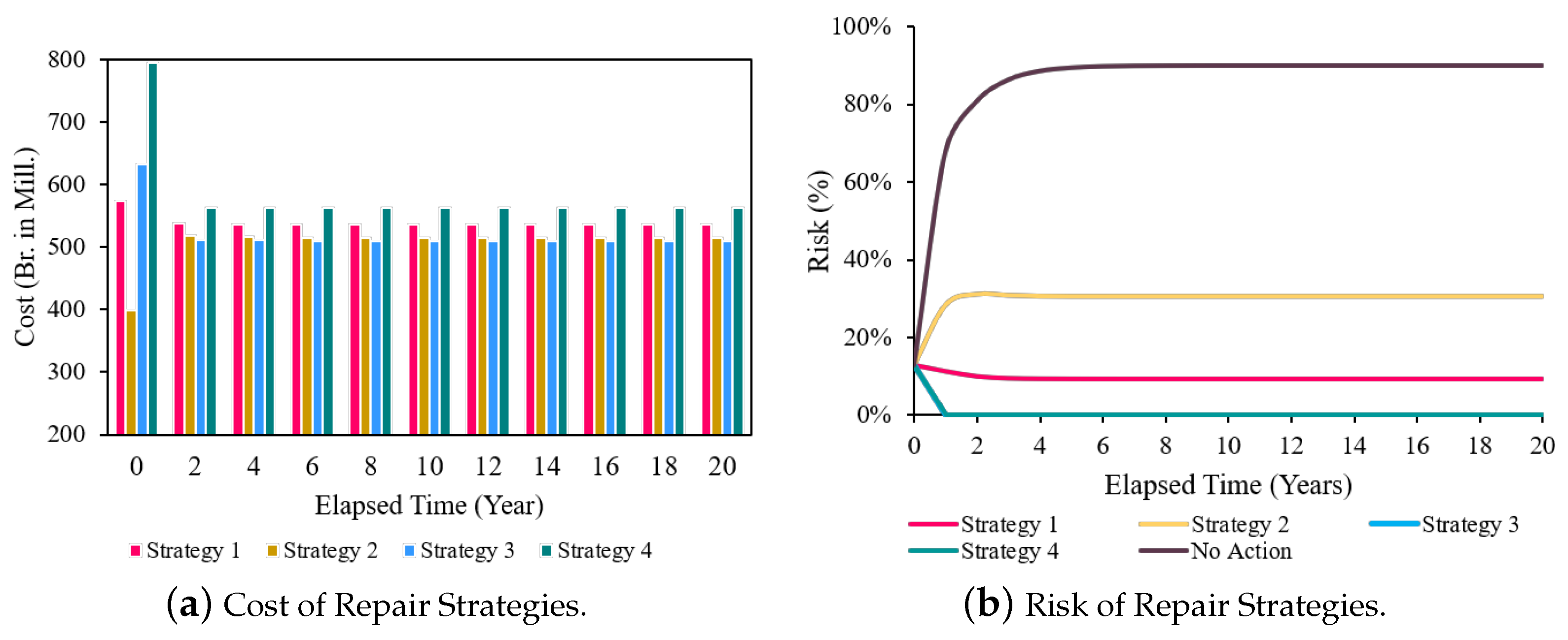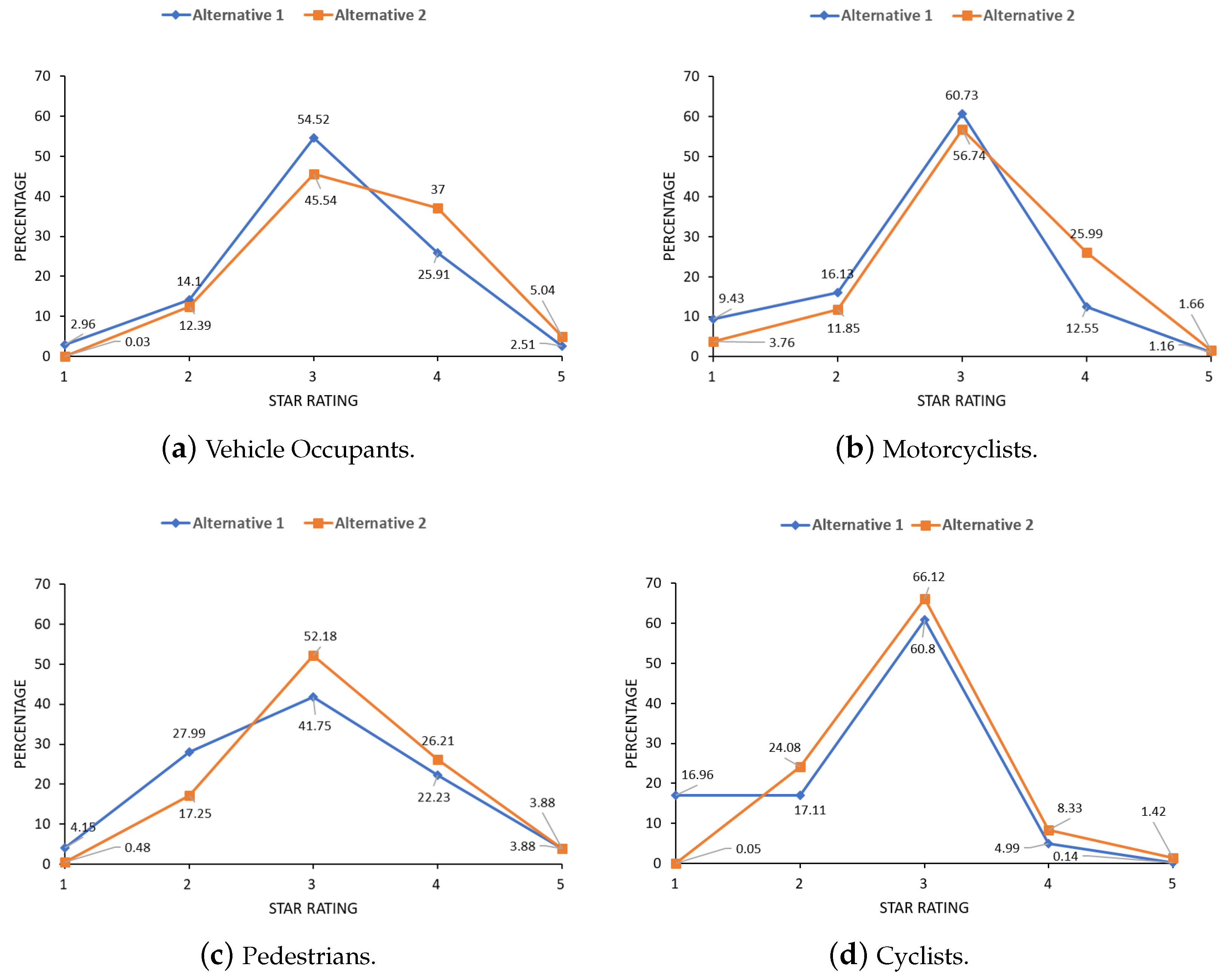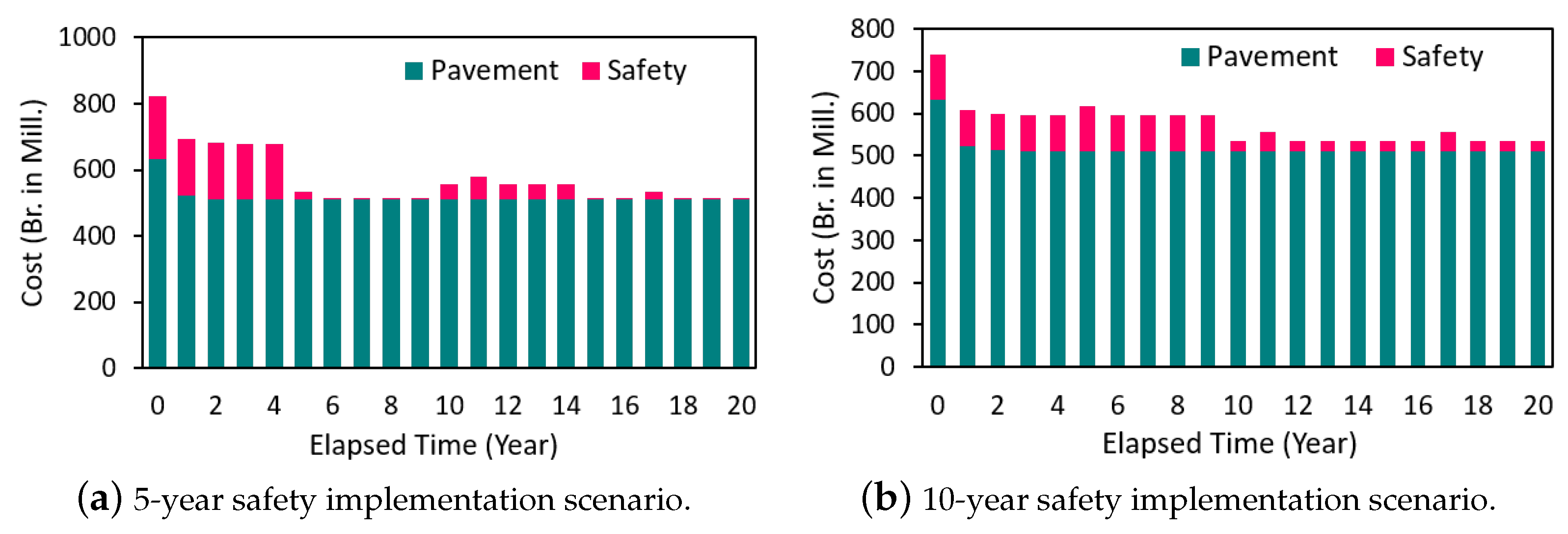Safety Integrated Network Level Pavement Maintenance Decision Support Framework as a Practical Solution in Developing Countries: The Case of Addis Ababa, Ethiopia
Abstract
:1. Introduction
2. Markov Process in Pavement Management
2.1. Markovian Pavement Deterioration Process
2.1.1. The Deterioration Prediction Model
2.1.2. Output of the Deterioration Prediction Model
2.2. Markovian Pavement Repair Process
The Repair Model
2.3. Life Cycle Cost and Risk Evaluation
3. Road Safety Analytics
3.1. Safety Analysis Input
3.2. The Safety Model
3.2.1. Star Rating
3.2.2. Fatality and Serious Injury (FSI) Estimation
3.2.3. Economic Analysis
3.2.4. Safety Analysis Procedure
4. Empirical Analysis: Performance Goal Setting and Repair Strategy (Counter-Measures) Evaluation
4.1. Pavement Management
4.2. Road Safety Analysis
5. Discussion
6. Conclusions
Author Contributions
Funding
Informed Consent Statement
Data Availability Statement
Acknowledgments
Conflicts of Interest
References
- Mazrekaj, R. Impact of road infrastructure on tourism development in Kosovo. Int. J. Manag. 2020, 11, 466–474. [Google Scholar]
- OECD. Impact of Transport Infrastructure Investment on Regional Development; Technical Report ITRD No. E112022; Organization for Economic Co-operation and Development: Paris, France, 2002.
- WHO. Global Status Report on Road Safety; Report; World Health Organization (WHO): Geneva, Switzerland, 2018.
- WHO; UNRC. Decade of Action for Road Safety 2021–2030; WHO: Geneva, Switzerland, 2021.
- Levik, K. How to sell the message “Road maintenance is necessary” to decision makers. In Proceedings of the Technology Transfer in Road Transportation in Africa, Arusha, Tanzania, 23–25 May 2001. [Google Scholar]
- Elghriany, A.; Yi, P.; Liu, P.; Yu, Q. Investigation of the effect of pavement roughness on crash rates for rigid pavement. J. Transp. Saf. 2016, 8, 164–176. [Google Scholar] [CrossRef]
- Tsubota, T.; Yoshii, T.; Shirayanagi, H.; Kurauchi, S. Effect of Pavement Conditions on Accident Risk in Rural Expressways. In Proceedings of the 2018 21st International Conference on Intelligent Transport Systems (ITSC), Maui, HI, USA, 4–7 November 2018. [Google Scholar]
- Vinayakamurthy, M. Effect of Pavement Condition on Accident Rate. Master’s Thesis, Arizona State University, Tempe, AZ, USA, 2017. [Google Scholar]
- Mkwata, R.; Chong, E. Effect of pavement surface conditions on road traffic accident—A Review. E3S Web Conf. 2022, 347, 01017. [Google Scholar] [CrossRef]
- Mamlouk, M.; Vinayakamurthy, M.; Underwood, B.S.; Kaloush, K.E. Effects of the International Roughness Index and Rut Depth on Crash Rates. TRR 2018, 2672, 418–429. [Google Scholar] [CrossRef]
- Al-Masaeid, H. Impact of pavement condition on rural road accidents. Can. J. Civ. Eng. 1997, 24, 523–531. [Google Scholar] [CrossRef]
- McCarthy, R.; Flintsch, G.; Izeppi, E.L. Impact of skid resistance on dry and wet weather crashes. J. Transp. Eng. B Pavements 2021, 147, 04021029. [Google Scholar] [CrossRef]
- Alhasan, A.; Nlenanya, I.; Smadi, O.; Mackenzie, C. Impact of pavement surface condition on roadway departure crash risk in Iowa. Infrastructures 2018, 3, 14. [Google Scholar] [CrossRef]
- Mayora, J.; Pina, R. An assessment of the skid resistance effect on traffic safety under wet-pavement conditions. Accid. Anal. Prev. 2009, 41, 881–886. [Google Scholar] [CrossRef] [PubMed]
- UNEC. Road Safety Performance Review Ethiopia; United Nations: Geneva, Swizerland, 2020.
- Ethiopian Federal Police Commission. Annual Crash Data Report; Annual Report; Ethiopian Federal Police Comission: Addis Ababa, Ethiopia, 2019.
- Addis Ababa City Transport Bureau. Road Traffic Crashes in Addis Ababa; Report; AACTB: Addis Ababa, Ethiopia, 2018. [Google Scholar]
- Banda, T. Investigating the Causes of Frequent Failures on Maintained Asphalt Pavement Federal Roads in Ethiopia. Master’s Thesis, Addis Ababa Science and Technology University, Addis Ababa, Ethiopia, 2018. [Google Scholar]
- Yitages, H. Economic Impact of Poor Pavement Maintenance in the City of Addis Ababa (A Case Study: Megenagna-Meskel Square-Torhayloch Road). Master’s. Thesis, Addis Ababa University, Addis Ababa, Ethiopia, 2017. [Google Scholar]
- Gebre, Z. Performance Assessment of Road Maintenance Project Management in Addis Ababa City Administration. Master’s Thesis, Addis Ababa University, Addis Ababa, Ethiopia, 2021. [Google Scholar]
- Agidew, D. Assessment of Road Maintenance Management Practices of Addis Ababa City Road Authority (AACRA). Master’s Thesis, Addis Ababa Science and Technology University, Addis Ababa, Ethiopia, 2017. [Google Scholar]
- Han, C.; Fang, M.; Ma, T.; Cao, H.; Peng, H. An intelligent decision-making framework for asphalt pavement maintenance using the clustering-PageRank algorithm. Eng. Optim. 2019, 52, 1829–1847. [Google Scholar] [CrossRef]
- de la Garza, M.J.; Akyildiz, S.; Bish, R.D.; Krueger, D.A. Network-level optimization of pavement maintenance renewal strategies. Adv. Eng. Inform. 2011, 25, 699–712. [Google Scholar] [CrossRef]
- Chen, W.; Zheng, M. Multi-objective optimization for pavement maintenance and rehabilitation decision-making: A critical review and future directions. Autom. Constr. 2021, 130, 103840. [Google Scholar] [CrossRef]
- He, S.; Salem, O.; Salman, B. Decision support framework for project-level pavement maintenance and rehabilitation through integrating life cycle cost analysis and life cycle assessment. J. Transp. Eng. Part B Pavements 2021, 147, 04020083-1–04020083-12. [Google Scholar] [CrossRef]
- Singh, A.; Sharma, A.; Mishra, R.; Wagle, M.; Sarkar, A. Pavement condition assessment using soft computing techniques. Int. J. Pavement Res. 2018, 11, 564–581. [Google Scholar] [CrossRef]
- Sayadinia, S.; Beheshtinia, M.A. Proposing a new hybrid multi-criteria decision-making approach for road maintenance prioritization. Int. J. Qual. Reliab. Manag. 2021, 38, 1661–1679. [Google Scholar] [CrossRef]
- Karimzadeh, A.; Shoghli, A. Predictive analytics for roadway maintenance: A review of current models, challenges, and opportunities. J. Civ. Eng. 2020, 6, 602–625. [Google Scholar] [CrossRef]
- Tsuda, Y.; Kaito, K.; Aoki, K.; Kobayashi, K. Estimating Markovian transition probabilities for bridge deterioration forecasting. JSCE J. Struct. Eng. Eng. 2006, 23, 241–256. [Google Scholar] [CrossRef]
- Han, D.; Kaito, K.; Kobayashi, K. Application of Bayesian estimation method with Markov hazard model to improve deterioration forecasts for infrastructure asset management. KSCE J. Civ. Eng. 2014, 18, 2107–2119. [Google Scholar] [CrossRef]
- Han, D. Development of Open-Source Hybrid Pavement Management System for an International Standard. Ph.D. Thesis, Kyoto University, Kyoto, Japan, 2011. [Google Scholar]
- Alaloul, W.S.; Altaf, M.; Musarat, M.A.; Javed, M.; Mosavi, A. Systematic review of life cycle assessment and life cycle cost analysis for pavement and a case study. J. Sustain. 2021, 13, 4377. [Google Scholar] [CrossRef]
- Sotic, A.; Rajic, R. The Review of the Definition of Risk. OJAKM 2015, 3, 17–26. [Google Scholar]
- iRAP Project Planning Manual; Version 1.0, Beta Edition; International Road Assessment Programme (iRAP): Bracknell, UK, 2019.
- iRAP Coding Manual; Version 5.1; International Road Assessment Programme (iRAP): Bracknell, UK, 2020.
- iRAP Star Rating and Investment Plan Manual; Version 1.1; International Road Assessment Programme (iRAP): Bracknell, UK, 2021.
- iRAP Methodology Fact Sheets; Version 3; International Road Assessment Programme (iRAP): Bracknell, UK, 2015.
- Martin, T.C. A Review of Existing Pavement Performance Relationships; ARRB Transport Research: Vermont South, Australia, 1996.
- Road Maintenance Plan Guideline, Project for Development of Road Maintenance Capacity of Addis Ababa; Japan International Cooperation Agency (JICA): Addis Ababa, Ethiopia, 2019.
- Pavement Condition Survey Implementation Manual; Japan International Cooperation Agency (JICA): Addis Ababa, Ethiopia, 2019.
- Alebachewu, F. Pavement Distresses on Addis Ababa City Arterial Roads, Causes and Maintenance Options. Master’s Thesis, Addis Ababa University, Addis Ababa, Ethiopia, 2005. [Google Scholar]
- Tullu, H. Assessment of Pavement Distresses in Addis Ababa City Road; Causes and Maintenance. Master’s Thesis, Addis Ababa University, Addis Ababa, Ethiopia, 2017. [Google Scholar]










| Classification | Core Level | Recommended Level | Advanced Level | |||
|---|---|---|---|---|---|---|
| Agency Cost | User Cost | Socio-Environ- mental Cost | ||||
| Vehicle Operating Cost (VOC) | Travel Time Cost | Accident | Work Zone | Emission Cost | ||
| Essential | · Maintenance | · Fuel | · Travel | · Property | · CO | |
| · Inspection | · Tire | time | damage | |||
| Optional | · Initial costs | · Depreciation, repair | · Injury | · Travel time and | · , HC | |
| · PMS operation | · Engine oil | · Fatality | VOC due to workzone | PM, Pb | ||
| Star Rating | Vehicle Occupants and Motorcyclists | Bicyclists | Pedestrians | ||
|---|---|---|---|---|---|
| Total | Along | Crossing | |||
| 5 | 0 to 2.5 | 0 to 5 | 0 to 5 | 0 to 0.2 | 0 to 4.8 |
| 4 | 2.5 to 5 | 5 to 10 | 5 to 15 | 0.2 to 1 | 4.8 to 14 |
| 3 | 5 to 12.5 | 10 to 30 | 15 to 40 | 1 to 7.5 | 14 to 32.5 |
| 2 | 12.5 to 22.5 | 30 to 60 | 40 to 90 | 7.5 to 15 | 32.5 to 75 |
| 1 | 22.5+ | 60+ | 90+ | 15+ | 75+ |
| Condition State | IRI (m/km) | Remark |
|---|---|---|
| 1 | IRI < 2 | Very Good |
| 2 | 2 ≤ IRI < 4 | Good |
| 3 | 4 ≤ IRI < 6 | Fair |
| 4 | 6 ≤ IRI < 8 | Poor |
| 5 | 8 ≤ IRI | Very Poor |
| Rating | 1 | 2 | 3 | 4 | 5 |
|---|---|---|---|---|---|
| 1 | 0.309 | 0.386 | 0.181 | 0.077 | 0.048 |
| 2 | - | 0.350 | 0.300 | 0.183 | 0.168 |
| 3 | - | - | 0.229 | 0.282 | 0.488 |
| 4 | - | - | - | 0.158 | 0.842 |
| 5 | - | - | - | - | 1 |
| Repair Types | Repair Action and Condition Transition |
|---|---|
| Preventive maintenance | = 1 |
| Partial overlay and Patching | = 2 |
| Mill and fill | = 1 |
| Full overlay | = 3 |
| Rehabilitation | = 1 |
| Reconstruction | = 1 |
| Rating | Road Network Safety Rating (%) | |||
|---|---|---|---|---|
| Vehicle Occupant | Motorcyclist | Pedestrian | Bicyclist | |
| 1 | 7.14 | 16.45 | 24.89 | 24.91 |
| 2 | 19.12 | 23.46 | 36.78 | 26.06 |
| 3 | 52.47 | 50.25 | 29.54 | 47.00 |
| 4 | 19.48 | 8.89 | 8.35 | 1.93 |
| 5 | 1.79 | 0.95 | 0.44 | 0.10 |
Disclaimer/Publisher’s Note: The statements, opinions and data contained in all publications are solely those of the individual author(s) and contributor(s) and not of MDPI and/or the editor(s). MDPI and/or the editor(s) disclaim responsibility for any injury to people or property resulting from any ideas, methods, instructions or products referred to in the content. |
© 2023 by the authors. Licensee MDPI, Basel, Switzerland. This article is an open access article distributed under the terms and conditions of the Creative Commons Attribution (CC BY) license (https://creativecommons.org/licenses/by/4.0/).
Share and Cite
Angelo, A.A.; Sasai, K.; Kaito, K. Safety Integrated Network Level Pavement Maintenance Decision Support Framework as a Practical Solution in Developing Countries: The Case of Addis Ababa, Ethiopia. Sustainability 2023, 15, 8884. https://doi.org/10.3390/su15118884
Angelo AA, Sasai K, Kaito K. Safety Integrated Network Level Pavement Maintenance Decision Support Framework as a Practical Solution in Developing Countries: The Case of Addis Ababa, Ethiopia. Sustainability. 2023; 15(11):8884. https://doi.org/10.3390/su15118884
Chicago/Turabian StyleAngelo, Asnake Adraro, Kotaro Sasai, and Kiyoyuki Kaito. 2023. "Safety Integrated Network Level Pavement Maintenance Decision Support Framework as a Practical Solution in Developing Countries: The Case of Addis Ababa, Ethiopia" Sustainability 15, no. 11: 8884. https://doi.org/10.3390/su15118884





